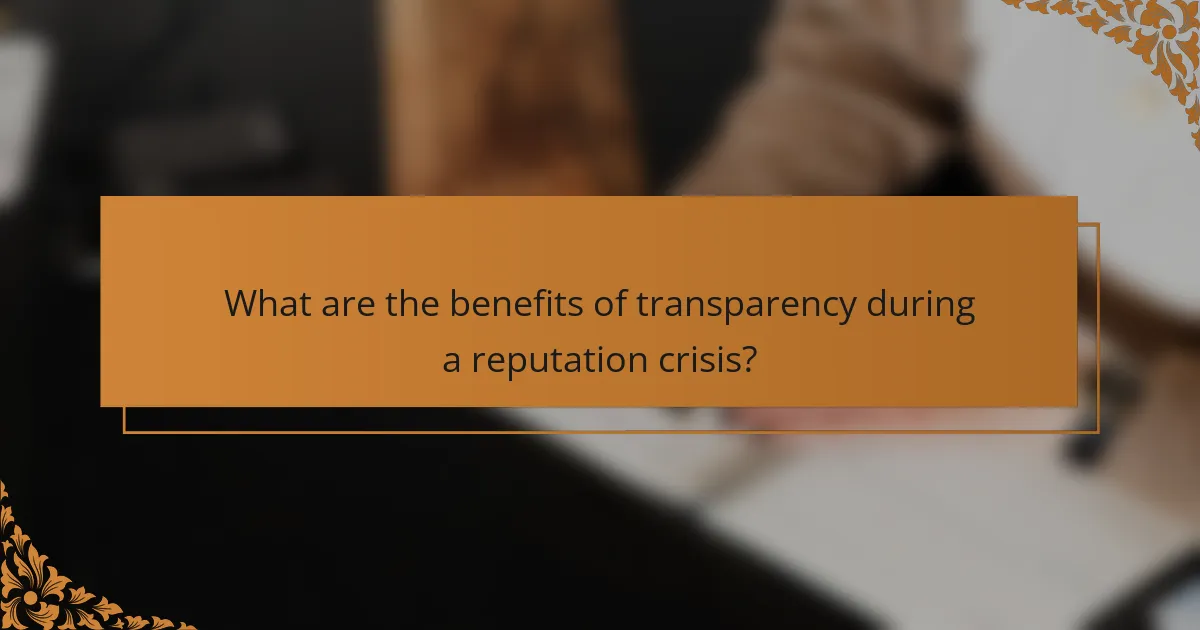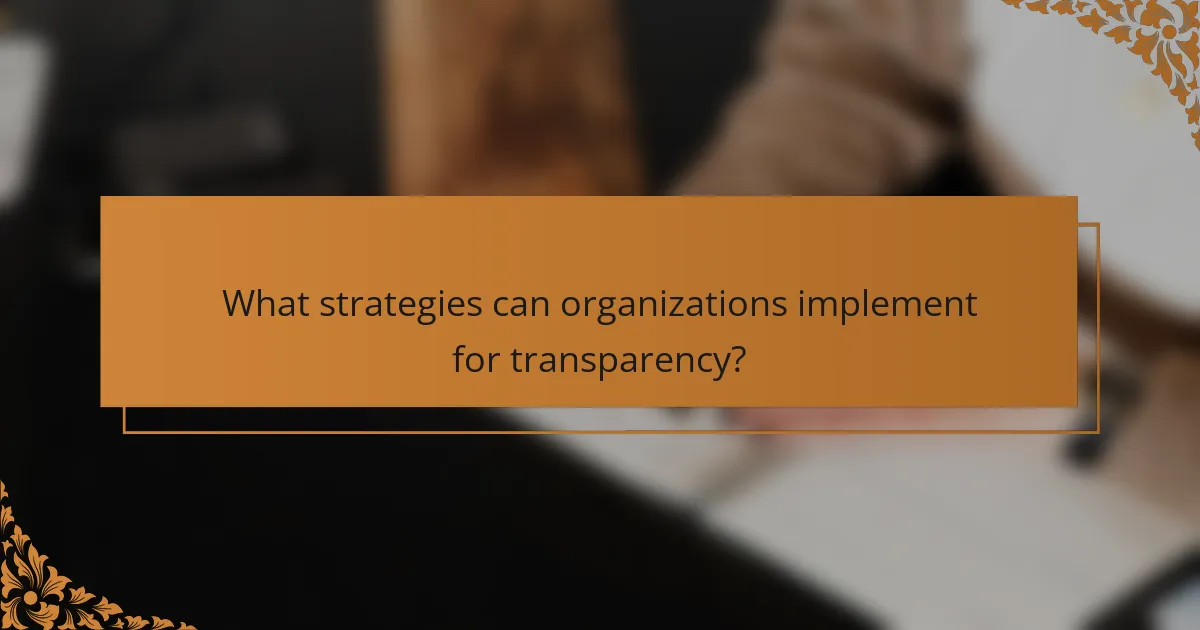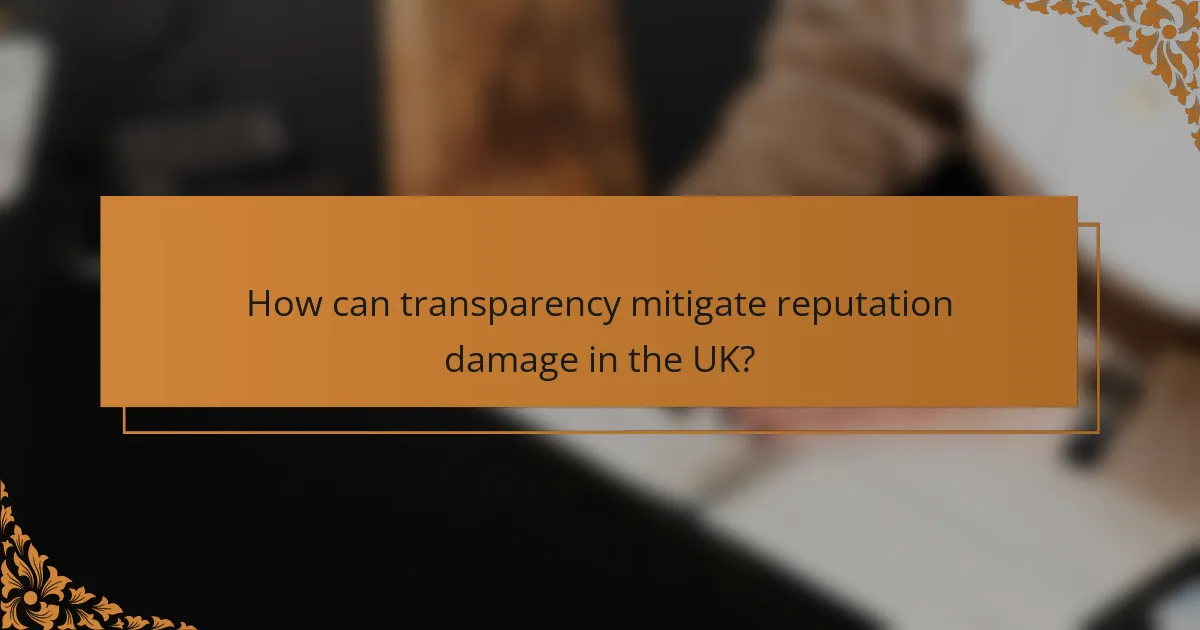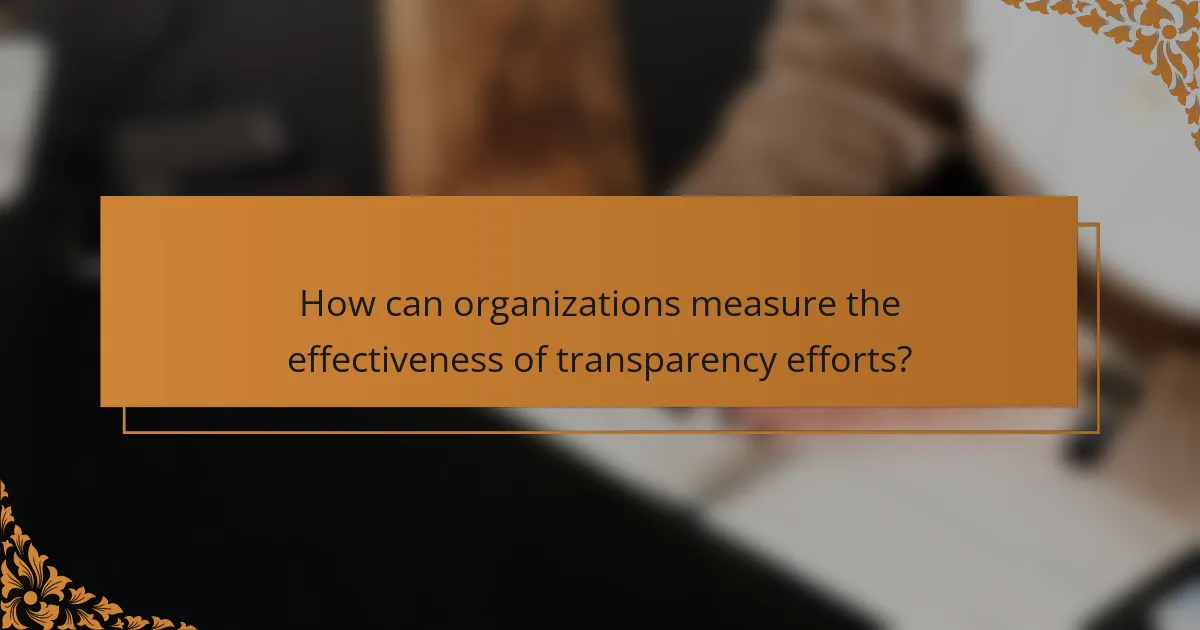In times of a reputation crisis, transparency plays a crucial role in mitigating damage and facilitating recovery. By openly communicating with stakeholders and providing regular updates, organizations can rebuild trust, enhance loyalty, and effectively navigate the challenges they face.

What are the benefits of transparency during a reputation crisis?
Transparency during a reputation crisis can significantly mitigate damage and foster recovery. By openly communicating with stakeholders, organizations can rebuild trust, enhance loyalty, and streamline recovery efforts.
Restores public trust
Being transparent about issues allows organizations to acknowledge mistakes and take responsibility, which is crucial for restoring public trust. When stakeholders see honesty, they are more likely to believe in the organization’s commitment to improvement.
For instance, a company facing a product recall should promptly inform customers about the situation, detailing the steps being taken to resolve it. This openness can turn a potential backlash into an opportunity for rebuilding credibility.
Enhances brand loyalty
Transparency can strengthen brand loyalty by demonstrating that an organization values its customers and stakeholders. When consumers feel informed and respected, they are more likely to remain loyal, even during tough times.
For example, a brand that openly shares its challenges and how it plans to overcome them can foster a deeper emotional connection with its audience. This approach often leads to increased customer retention and advocacy.
Improves stakeholder communication
Clear and honest communication with stakeholders is vital during a reputation crisis. Transparency helps to ensure that all parties are on the same page, reducing misunderstandings and misinformation.
Organizations should establish regular updates through various channels, such as social media, press releases, and newsletters. This proactive communication strategy can keep stakeholders informed and engaged, minimizing speculation and confusion.
Facilitates quicker recovery
Transparency can significantly speed up recovery from a reputation crisis. By addressing issues head-on and providing clear information, organizations can resolve problems more efficiently and regain stakeholder confidence faster.
For instance, a company that quickly admits to a data breach and outlines its corrective actions is likely to recover more swiftly than one that remains silent. Timely transparency can lead to a more favorable public perception and quicker restoration of normal operations.

What strategies can organizations implement for transparency?
Organizations can implement several strategies to enhance transparency during a reputation crisis, including fostering open communication, providing regular updates, and engaging with stakeholders. These approaches help build trust and mitigate the impact of the crisis.
Open communication channels
Establishing open communication channels is crucial for transparency. Organizations should utilize various platforms such as social media, press releases, and dedicated websites to disseminate information. This ensures that stakeholders receive timely updates directly from the source.
Encouraging two-way communication allows stakeholders to ask questions and express concerns. Organizations can set up hotlines or online forums to facilitate this interaction, which can help address issues before they escalate.
Regular updates on progress
Providing regular updates on progress is essential for maintaining transparency during a crisis. Organizations should commit to a schedule for sharing information, whether daily, weekly, or bi-weekly, depending on the severity of the situation. This consistency helps stakeholders feel informed and involved.
Updates should include clear information about actions taken, outcomes achieved, and any challenges faced. Using bullet points can help present this information succinctly, making it easier for stakeholders to digest.
Engagement with affected stakeholders
Engaging with affected stakeholders is a vital strategy for transparency. Organizations should identify key stakeholders, including customers, employees, and community members, and actively involve them in the recovery process. This can be done through surveys, focus groups, or public meetings.
Listening to stakeholder feedback and incorporating it into decision-making can significantly enhance trust. Organizations should also be prepared to address concerns openly and honestly, demonstrating a commitment to accountability and improvement.

How can transparency mitigate reputation damage in the UK?
Transparency can significantly reduce reputation damage in the UK by fostering trust and accountability. When organizations openly communicate about challenges and their responses, they can maintain stakeholder confidence and mitigate negative perceptions.
Case studies of successful UK brands
Several UK brands have effectively used transparency to navigate reputation crises. For instance, a well-known retail chain openly addressed supply chain issues during a product shortage, providing regular updates to customers. This proactive communication helped retain customer loyalty and minimized backlash.
Another example is a major bank that faced data breaches. By promptly informing customers about the breach and the steps taken to enhance security, the bank not only complied with regulatory requirements but also reinforced its commitment to customer safety, resulting in a quicker recovery of its reputation.
Legal compliance and ethical considerations
In the UK, transparency in crisis management must align with legal standards such as the General Data Protection Regulation (GDPR). Organizations are required to disclose data breaches promptly, ensuring that affected individuals are informed about the nature of the breach and the measures taken to address it.
Ethically, companies should strive for honesty and integrity in their communications. Misleading information can lead to legal repercussions and further damage to reputation. Establishing clear guidelines for communication during a crisis can help ensure that all messaging is both compliant and ethically sound.

What best practices should organizations follow?
Organizations should prioritize clear communication, proactive engagement, and employee training to effectively manage reputation crises. Implementing structured strategies can enhance transparency and rebuild trust with stakeholders.
Develop a crisis communication plan
A crisis communication plan outlines the steps an organization will take during a reputation crisis. This plan should include key messages, designated spokespersons, and communication channels to be used. Regularly updating this plan ensures it remains relevant and effective.
Consider conducting scenario-based drills to prepare for various crisis situations. This practice helps identify potential weaknesses in the plan and allows for adjustments before a real crisis occurs.
Utilize social media effectively
Social media is a powerful tool for transparency during a reputation crisis. Organizations should monitor platforms for mentions and respond promptly to concerns or misinformation. Engaging with audiences in real-time can help mitigate negative perceptions.
Establishing a dedicated social media team can enhance responsiveness. Use clear, consistent messaging across all channels to reinforce trust and credibility. Regular updates on the organization’s actions can further reassure stakeholders.
Train staff on transparency protocols
Training staff on transparency protocols is crucial for maintaining a unified response during a crisis. Employees should understand the importance of honesty and openness in communication, as well as their roles in executing the crisis communication plan.
Regular workshops and simulations can help staff practice these protocols. Encourage a culture of transparency where employees feel empowered to share information and address concerns proactively. This approach fosters trust internally and externally.

How can organizations measure the effectiveness of transparency efforts?
Organizations can measure the effectiveness of their transparency efforts through various methods that gauge stakeholder perceptions and media responses. Key metrics include feedback from stakeholders and analysis of media coverage, which provide insights into public sentiment and the impact of transparency initiatives.
Stakeholder feedback surveys
Conducting stakeholder feedback surveys is a direct way to assess the effectiveness of transparency efforts. These surveys can include questions about trust levels, clarity of communication, and perceived honesty. Organizations should aim for a response rate of at least 20-30% to ensure meaningful results.
To enhance the quality of feedback, consider using a mix of quantitative and qualitative questions. For example, a Likert scale can quantify trust levels, while open-ended questions can provide deeper insights into stakeholder concerns. Regularly conducting these surveys, perhaps quarterly or bi-annually, helps track changes over time.
Media coverage analysis
Media coverage analysis involves reviewing how transparency efforts are portrayed in news articles, blogs, and social media. This analysis can reveal public perception and highlight areas where communication may be lacking. Key metrics to consider include the volume of coverage, tone (positive, negative, neutral), and the reach of the media outlets involved.
Organizations should monitor media mentions regularly, using tools that aggregate news and social media content. A practical approach is to categorize coverage into themes, such as crisis management or corporate social responsibility, to identify trends and adjust strategies accordingly. Aim to review media coverage at least monthly to stay responsive to public sentiment.

What role does leadership play in promoting transparency?
Leadership is crucial in fostering transparency during a reputation crisis. Effective leaders set the tone for open communication, ensuring that stakeholders are informed and engaged throughout the process.
Setting a transparent culture
Creating a transparent culture starts with establishing clear values that prioritize honesty and openness. Leaders should encourage team members to share information freely and voice concerns without fear of repercussions. This can be achieved through regular meetings and feedback sessions.
Implementing policies that support transparency, such as open-door policies or anonymous reporting channels, can further enhance this culture. Regularly communicating the importance of transparency helps reinforce these values across the organization.
Leading by example
Leaders must embody the principles of transparency in their actions. By openly sharing information about decisions and challenges, they demonstrate the importance of honesty. This behavior encourages employees to adopt similar practices in their interactions.
Additionally, leaders should acknowledge mistakes and take responsibility when necessary. This not only builds trust but also shows that transparency is valued at all levels of the organization. Regularly highlighting examples of transparent behavior can motivate others to follow suit.

What are the challenges of maintaining transparency?
Maintaining transparency during a reputation crisis involves navigating various challenges, including managing public perception and ensuring that sensitive information is handled appropriately. Organizations must balance the need for openness with the necessity of protecting privacy and proprietary information.
Balancing privacy and openness
Balancing privacy and openness is crucial for organizations facing a reputation crisis. While transparency can help rebuild trust, revealing too much information can compromise sensitive data or violate privacy regulations. Companies should assess what information is essential for public knowledge and what should remain confidential.
To achieve this balance, organizations can adopt a tiered communication strategy. For instance, they can share general updates about the situation while withholding specific details that could harm individuals or the organization. This approach allows for transparency without jeopardizing privacy.
Common pitfalls include oversharing information that could lead to further reputational damage or failing to communicate adequately, which can foster distrust. A checklist for maintaining this balance includes: identify key stakeholders, determine what information is necessary, and establish clear communication protocols to guide disclosures.
